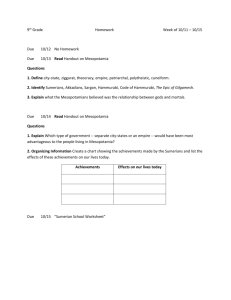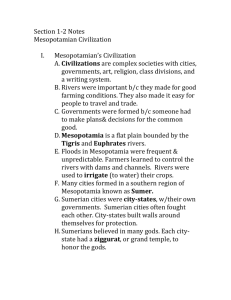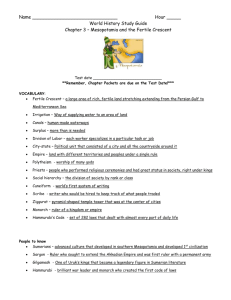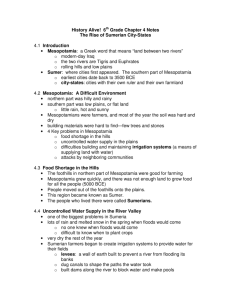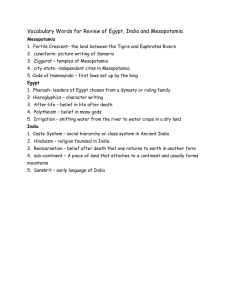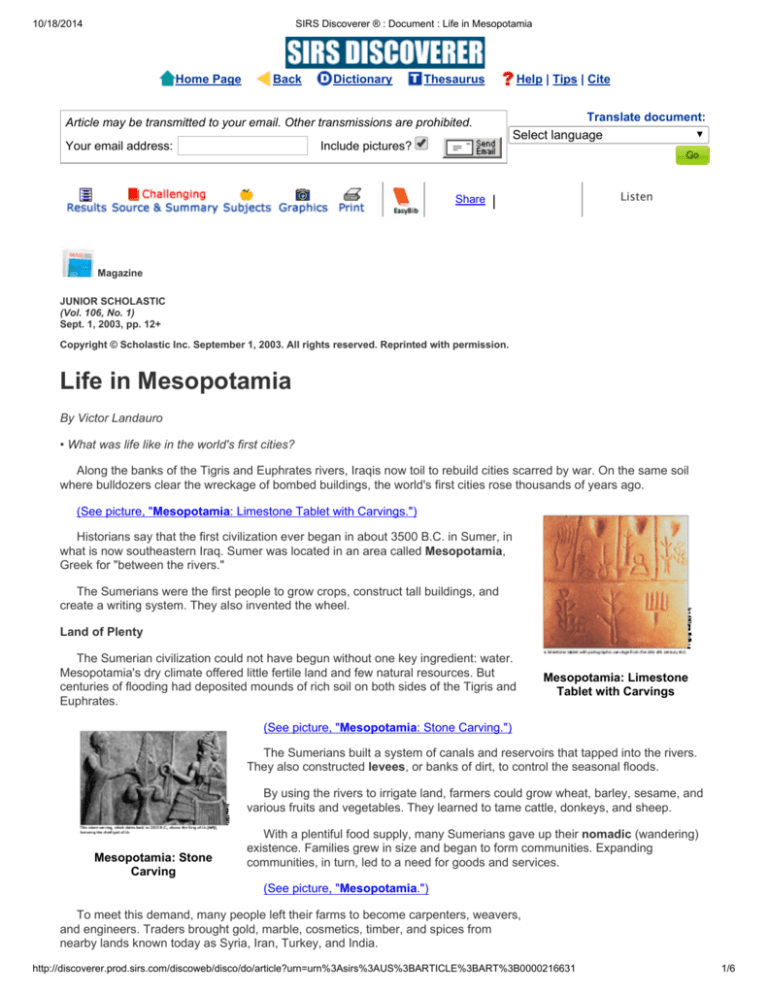
10/18/2014
SIRS Discoverer ® : Document : Life in Mesopotamia
Home Page
Back
Dictionary
Thesaurus
Help | Tips | Cite
Translate document:
Select language
Article may be transmitted to your email. Other transmissions are prohibited.
Your email address:
Include pictures?
Share
Listen
Share
Share
onShare
on
facebook
on
twitter
on
gmail
stumbleupon
| Share
Magazine
JUNIOR SCHOLASTIC
(Vol. 106, No. 1)
Sept. 1, 2003, pp. 12+
Copyright © Scholastic Inc. September 1, 2003. All rights reserved. Reprinted with permission.
Life in Mesopotamia
By Victor Landauro
• What was life like in the world's first cities?
Along the banks of the Tigris and Euphrates rivers, Iraqis now toil to rebuild cities scarred by war. On the same soil
where bulldozers clear the wreckage of bombed buildings, the world's first cities rose thousands of years ago.
(See picture, "Mesopotamia: Limestone Tablet with Carvings.")
Historians say that the first civilization ever began in about 3500 B.C. in Sumer, in
what is now southeastern Iraq. Sumer was located in an area called Mesopotamia,
Greek for "between the rivers."
The Sumerians were the first people to grow crops, construct tall buildings, and
create a writing system. They also invented the wheel.
Land of Plenty
The Sumerian civilization could not have begun without one key ingredient: water.
Mesopotamia's dry climate offered little fertile land and few natural resources. But
centuries of flooding had deposited mounds of rich soil on both sides of the Tigris and
Euphrates.
Mesopotamia: Limestone
Tablet with Carvings
(See picture, "Mesopotamia: Stone Carving.")
The Sumerians built a system of canals and reservoirs that tapped into the rivers.
They also constructed levees, or banks of dirt, to control the seasonal floods.
By using the rivers to irrigate land, farmers could grow wheat, barley, sesame, and
various fruits and vegetables. They learned to tame cattle, donkeys, and sheep.
Mesopotamia: Stone
Carving
With a plentiful food supply, many Sumerians gave up their nomadic (wandering)
existence. Families grew in size and began to form communities. Expanding
communities, in turn, led to a need for goods and services.
(See picture, "Mesopotamia.")
To meet this demand, many people left their farms to become carpenters, weavers,
and engineers. Traders brought gold, marble, cosmetics, timber, and spices from
nearby lands known today as Syria, Iran, Turkey, and India.
http://discoverer.prod.sirs.com/discoweb/disco/do/article?urn=urn%3Asirs%3AUS%3BARTICLE%3BART%3B0000216631
1/6
10/18/2014
SIRS Discoverer ® : Document : Life in Mesopotamia
Life in the Big City
By 3000 B.C., about 12 cities thrived on the Sumerian plain. These urban centers,
such as Ur, Eridu, Nippur, and Uruk, were called city-states--independent areas with
their own government and culture. Tens of thousands of people lived in these cities
and their surrounding villages and farms. The fiercely competitive city-states often
waged war over land and water rights.
Mesopotamia
Most urban dwellers lived in one- or two-story mud-brick houses. They whitewashed the interior and exterior walls to
keep rooms cool. Wealthy people built houses made of imported wood and stone.
Most women stayed at home to prepare meals, manage the household, and train their daughters to become wives
and mothers. Women also worked as weavers, potters, and jewelry makers. They typically wore gowns tied at the
shoulders with their right arms exposed. Wealthier women wore elaborate headdresses made of metals and precious
stones.
Men controlled nearly every aspect of life. They wore kiltlike garments and worked as soldiers, traders, farmers, and
craftsmen.
Sumerians believed that a personal god was assigned to each man. (Women were not deemed important enough for
the gods.) The men prayed to these gods for long and prosperous lives.
Sumerian Inventions
Sumerians assigned a specific god to each city-state. They often fought wars over these gods.
As a form of worship, Sumerians built a pyramid-shaped temple in the center of each city-state. These seven- and
eight-story structures, called ziggurats, were constructed with baked mud-bricks and dominated the skyline.
(See picture, "Mesopotamia: Ancient Babylonian Temple.")
The rooms inside were adorned with murals and statues made from imported
marble, alabaster, and colored stones. Temple farmers raised food and animals for
religious sacrifices.
Mesopotamia: Ancient
Babylonian Temple
A king-priest ruled each city-state and helped to defend it. He also oversaw
irrigation and agricultural projects, road and temple building, and the enforcement of
laws.
The idea of monarchy began in Sumer. At first, community elders appointed a male
to serve as a temporary ruler during a time of crisis or war. When the emergency ended, the ruler would cede (give up)
his leadership role back to the elders. But as time passed, these rulers became reluctant to give up power. Success in
battle, interpreted as pleasing to the gods, could also extend a leader's rule.
Temple priests helped the king-priest to administer religious and government duties. They surveyed land, distributed
surplus grains, organized religious and educational services, and sponsored trade expeditions abroad.
All of this activity led to a need for record keeping. So, Sumerians created a written language of crude symbols. Early
writers used sharpened reeds to draw pictographs, or "word pictures," onto wet clay tablets. The tablets hardened into
permanent stone records.
Eventually, the writing system was simplified into a series of wedge-shaped lines called cuneiform (kyu-NEE-uhFORM). This alphabet allowed for greater freedom in expressing words and ideas. The Sumerian alphabet consisted of
more than 600 symbols.
Since few Sumerians could read or write, they hired scribes, or professional writers, to prepare documents for them.
Scribes trained for years at schools, or edubbas. They studied mathematics, accounting, engineering, and literature.
Only upper-class boys could attend such schools.
The ability to keep permanent records led to the creation of a legal system. The Sumerian king Ur-Nammu devised a
set of rules that he hoped would help govern and unify all Sumerians.
His first laws called for the dismissal of corrupt government officials; he also established a standard set of weights and
measures. Other laws protected widows, the elderly, and orphans. Royal scribes carved the laws onto clay tablets that
were displayed throughout the city.
(See picture, "Mesopotamia: Excavation of Khorsabad.")
http://discoverer.prod.sirs.com/discoweb/disco/do/article?urn=urn%3Asirs%3AUS%3BARTICLE%3BART%3B0000216631
2/6
10/18/2014
SIRS Discoverer ® : Document : Life in Mesopotamia
Sometime around 3500 B.C., an unknown craftsman built the first wheeled cart.
This device allowed farmers to haul heavier loads to market. The carts also served
military purposes. Donkeys led chariots into battle, allowing soldiers greater speed
and mobility.
The Destruction of Sumer
Sometime in the 1700s B.C., foreign invaders conquered Mesopotamia. The
invasion brought an end to the region's independent city-states. The Sumerian
civilization died almost completely.
Mesopotamia: Excavation
of Khorsabad
(See picture, "Mesopotamia: Sumerian
Mosaic.")
But Sumerian inventions lived on. From ziggurats, we have skyscrapers. From
cuneiform tablets, we have newspapers, magazines, and other printed media. The
world's school systems, codes of law, and alphabets all draw from this civilization that
once sprouted between two mighty rivers.
Mesopotamia: Sumerian
Mosaic
Mesopotamia Time Line
5000 B.C.: Nomads from the area that is now Iran begin to settle in southeastern Mesopotamia. These early settlers
plant wheat and barley and tame animals.
3500 B.C.: The Sumerians settle along the Euphrates and begin to build ziggurats (temples). They also create a crude
writing system.
3000 B.C.: Nippur, Ur, and Eridu become the leading Sumerian cities. Sumerian writing evolves to include cuneiform
letters.
2750 B.C.: Gilgamesh, the hero of Sumerian legends, becomes king of the city-state Uruk.
2250 B.C.: Ur-Nammu, king of Ur, creates one of the world's earliest law systems. The new laws call for the greater
protection of widows, orphans, and the poor.
2000-1900 B.C.: Foreign invaders conquer areas of Mesopotamia. Ur, the most-advanced Sumerian city-state, is
destroyed.
1800 B.C.: Hammurabi ascends to the throne of Babylonia. He unites all the city-states under one kingdom and
introduces his own law code.
1100 B.C.: Mesopotamians begin to use iron to make tools and weapons.
600 B.C.: Construction begins on the Tower of Babel by the descendants of Noah, as told in the Bible.
(See picture, Mesopotamia: The Tower of Babel)
Treasures Found--and Lost
Many of the Mesopotamian artifacts feared looted from the Baghdad National
Museum are safe. Cultural officials in Iraq have discovered underground vaults where
priceless artifacts were stored. Museum workers hid the relics before the Iraqi war
began last March.
Mesopotamia: The Tower
of Babel
(See picture, "Mesopotamia: Bull's Head
Decoration.")
"It is a relief that so much of the museum's main
collection is safe and in good condition," said Pietro
Cordone, an official with the U.S.-led interim authority.
Recovered items include gold bracelets, bronze bowls,
and clay pots that date from the 6th century B.C.
But the looting of Mesopotamian artifacts continues in other areas of Iraq. Thieves
have raided several major archaeological sites.
http://discoverer.prod.sirs.com/discoweb/disco/do/article?urn=urn%3Asirs%3AUS%3BARTICLE%3BART%3B0000216631
3/6
10/18/2014
SIRS Discoverer ® : Document : Life in Mesopotamia
"I think much more is leaving the country now from these sites than from the
museums," says one archaeologist in Iraq.
Mesopotamia: Bull's
Head Decoration
Your Turn
Word Match
1.
2.
3.
4.
5.
city-state
ziggurat
nomadic
scribe
cede
A.
B.
C.
D.
E.
give up
pyramid-shaped temple
independent city and its surrounding territory
professional writer
wandering
Think About It
How did the invention of writing lead to other significant social, economic, and legal developments in Mesopotamia?
Web
Mesopotamia
www.mesopotamia.co.uk
Objectives
Students should understand:
• The world's first civilizations began in Mesopotamia, the area between the Tigris and Euphrates rivers, sometime
around 3500 B.C.
Teaching Strategy
Ask students to imagine that they lived in Sumer, the world's first civilization, in about 3000 B.C. What kind of clothes
might they have worn? What kinds of jobs would they have had? How would their city have been governed? What
characteristics of our society also existed 5,000 years ago?
Background
Many aspects of Sumerian society are still with us today. Sumerian law codes influenced the legal systems of ancient
Greece and Rome, which, in turn, helped shape our own democratic ideals. We get our 60 seconds in a minute and 60
minutes in an hour from the Sumerians' sexagesimal system which counts by 60.
Thinking Skills
Comprehension: Why was irrigation important to the development of Sumerian civilization? (Through irrigation,
farmers were able to provide Sumer with a stable food supply. The Sumerians could spend less time raising food and
more time developing the systems that can run a large society.)
Making Connections: What advantages did wealthy boys in Sumer enjoy? (These boys had more social and
educational opportunities than other children. They could attend school and study law, mathematics, engineering,
literature, and writing.)
Activity
The Sumerian Times: Divide the class into small groups, and ask them to create short newspaper-style stories about
daily life in Sumer. Students should write about various events, including those dealing with Sumerian government,
religion, and culture. Students can collect their stories together as a newspaper.
Resources
Print
http://discoverer.prod.sirs.com/discoweb/disco/do/article?urn=urn%3Asirs%3AUS%3BARTICLE%3BART%3B0000216631
4/6
10/18/2014
SIRS Discoverer ® : Document : Life in Mesopotamia
• Ali, Daud, Great Civilizations of the East (Southwater Publishers, 2001). Grades 5-8.
• Moss, Carol, Science in Mesopotamia (Scholastic, 1999). Grades 5-8.
Web Sites
• Mesopotamia
www.mesopotamia.co.uk/
• Sumer
www.crystalinks.com/sumer.html
Quick Quiz
Write the letter of the correct answer on the line provided.
__ 1. What does the word Mesopotamia mean in Greek?
A. fertile land
B. between the rivers
C. home of the gods
__ 2. Sumer is located in which modern-day nation?
A. Iraq
B. Turkey
C. Syria
__ 3. By irrigating their land, the Sumerians were able to do which of the following?
A. win major battles with rival city-states
B. continue their nomadic way of life
C. develop a stable and plentiful food supply
__ 4. What could Sumerian women become?
A. priests and scribes
B. weavers, potters, and jewelry makers
C. schoolteachers for young girls
__ 5. The invention of a writing system led to which other important Sumerian development?
A. the creation of an early law code
B. the building of the ziggurats
C. the increase in the power of king-priests
Answers
1. B
2. A
3. C
4. B
5. A
Citation :
You can copy and paste this information into your own documents.
Landauro, Victor. "Life in Mesopotamia." Junior Scholastic (Vol. 106, No. 1). Sept. 1 2003: 12+. SIRS
Discoverer. Web. 18 Oct. 2014.
http://discoverer.prod.sirs.com/discoweb/disco/do/article?urn=urn%3Asirs%3AUS%3BARTICLE%3BART%3B0000216631
5/6
10/18/2014
SIRS Discoverer ® : Document : Life in Mesopotamia
Home Page | Current Events | Spotlight of the Month | World Almanac | Encyclopedia
Dictionary | Thesaurus | Help | Tips | Cite | Workbooks | Tutorial | Research Topics
Educators' Resources | Privacy | Accessibility | License | Mobile Site | Contact
Copyright © 2014 ProQuest LLC. All rights reserved.
http://discoverer.prod.sirs.com/discoweb/disco/do/article?urn=urn%3Asirs%3AUS%3BARTICLE%3BART%3B0000216631
6/6





